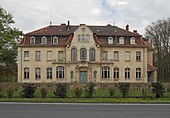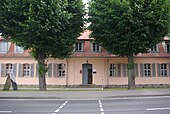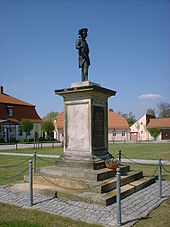Zinna Monastery (Jüterbog)
|
Zinna Monastery
City of Jueterbog
Coordinates: 52 ° 1 ′ 28 ″ N , 13 ° 6 ′ 17 ″ E
|
|
|---|---|
| Height : | 64 m above sea level NHN |
| Residents : | 1160 (December 31, 2011) |
| Incorporation : | December 31, 1997 |
| Postal code : | 14913 |
| Area code : | 03372 |
The place Kloster Zinna is a district of the Brandenburg town Jüterbog in Germany , three kilometers north of Jüterbog. The former Zinna monastery is located in the village .
history
Early to the 17th century
The local area was already settled in the Bronze Age. Later Slavs settled here , the place name goes back to the Slavic name Cenna . In 1170 founded archbishop of Magdeburg Wichmann the monastery to the area under cultivation to make while Christianize . Around 1350 around 60 monks and 100 lay brothers lived in Zinna. Economic and cultural life flourished. For example, around 1493 the monks printed the Zinnaer Marienpsalter ; which is considered to be the oldest book in Brandenburg. With the Reformation , the monks left the area in 1553. The monastery came into the possession of the Magdeburg sovereign office. In 1648, the last administrator Christian Wilhelm von Brandenburg was awarded the place as his property for life. He ran a small farm and died in Zinna in 1665. In 1680 the office fell to the Kurmark . The Nuthe presented at this time is the border to Saxon Jüterbog.
18th century
The Seven Years' War also left its mark on Zinna when Prussian troops marched into Saxony from here too. King Friedrich II founded a weavers' colony in 1764 and had 220 unit houses built for craftsmen. They planted around 300 mulberry trees to make silk. A street grid was created with intersecting streets and a central square. The four blocks enclosed a garden. The place flourished, and more artisans, innkeepers and weavers settled there. The weavers organized themselves in 1769 by founding a guild and built their own master house. In 1771, 24 weavers lived in the village. The factory was built in 1776, and in the 21st century it is the house at Berliner Straße 72. The main construction phase of the town ended around 1780. At that time, 774 people lived in 149 houses in Zinna. The weavers were further supported by the brotherhood of journeyman weavers founded in 1779.
19th century
In 1872 the settlement was combined with the administrative area of the monastery. At the beginning of the 19th century, the economic future of the place seemed secure. Zinna now had around 1045 inhabitants. However, woolen cloth factories settled in neighboring Luckenwalde , which could produce more cheaply in the course of industrialization. This led to high unemployment in Zinna - more than two thirds of the weavers lost their jobs. Nevertheless, the weavers maintained their traditions, such as the annual weaver carnival , at which the masters and journeymen celebrated their successfully completed final exams . In 1847 the Jüterbog district administrator banned this extravagant festival, whereupon the teacher Eduard Wegener introduced a school festival. This event will continue as a local festival into the 21st century. In 1864 the residents erected a monument to their king on the central square as thanks for the establishment of the town. It was destroyed in 1949.
20th century to modern times
In 1919 two Jewish manufacturers founded a plush weaving mill, which was closed in 1937 in the course of Aryanization and converted into a VEB in 1948 . After the fall of the Wall , this company also had to give up. In 1929 Zinna lost its town charter. In 1956 the museum of local history opened in the abbey of the monastery. Since 1992 Zinna Monastery has belonged to the Jüterbog office. In 1994 the community rebuilt the monument to Frederick II. On December 31, 1997, the place became a district of Jüterbog.
Culture and sights
- Zinna Monastery , former Cistercian monastery, 1170–1553, with preserved church, abbot house and farm building, museum
- Former weavers' settlement from the 18th century with weaving museum at Berliner Straße 72.
- The Kaltenhausen estate north of the village, originally on the outskirts of the monastery, first mentioned in 1480. In 1800 125 people lived in the manor district. In 1832 the Bohnstedt family acquired the estate. The Bohnstedt family had the manor house built between 1902 and 1904 in the neo-baroque style based on a design by the Berlin architects Cremer & Wolffenstein . The manor house temporarily served as a primary school.
- At the western end of the former monastery district there is a linden tree as a natural monument , which is said to have been planted in the 12th century to baptize the last pagan Slavs. The tree is a scene in the work The German Michael by Albert Emil Brachvogel . A little boy, Michael von Felgentreu , wants to find out his true identity in it. However, he is prevented from doing so by his father and imprisoned in the monastery. Michael escapes through a prison window, rises to the top of the tree and is able to escape. In older writings there is also the name Linde from the German Michael . The tree was badly damaged by fire on New Year's Eve 1996.
- On the market square there is a monument to Frederick the Great , who founded the weaver colony. According to the inscription on the back, it was destroyed in 1949, but renovated on April 8, 1994 through donations from residents and guests of the village and the statue of M. Starke and F. Woike donated. The front bears the inscription:
| Frederick the Great, founder of the city in 1764, the thankful Zinna Monastery in 1864 |
- A circular wall path leads around the site over a length of four kilometers.
- The former Forst Zinna military area is located three kilometers north of the district . In the 21st century it is part of the Nuthe-Nieplitz Nature Park .
literature
- Marie-Luise Buchinger, Marcus Cante: Monument topography Federal Republic of Germany . Monuments in Brandenburg. District of Teltow-Fläming 17.1 = town of Jüterbog with monastery Zinna and municipality Niedergörsdorf . Wernersche Verlagsgesellschaft , Worms, 2000. ISBN 978-3-88462-154-7
- Gerhard Vinken et al. (Ed.): Handbook of German Art Monuments . Brandenburg. Deutscher Kunstverlag, Munich / Berlin 2000, ISBN 3-422-03054-9 .
Web links
Individual evidence
- ↑ Müller's Large German Local Book 2012: Complete local dictionary. 33. revised and exp. Ed., Walter de Gruyter, Berlin and Boston 2012, ISBN 978-3-11-027420-2 , online at Google Books , p. 739
- ↑ Information board Die Weber , on the oak at the monument, inspection in March 2015.
- ↑ Information panel for a short local history , at the monastery, inspection in March 2015.
- ^ StBA: Changes in the municipalities, see 1997
- ^ Carsten Preuß, Hiltrud Preuß: The manor houses and mansions in the Teltow-Fläming district. Lukas Verlag, Berlin 2011 ISBN 978-3-86732-100-6 pp. 106-109
- ↑ Information board , shrouded in legend , Heidenlinde , on the Linde, inspection in March 2015.




